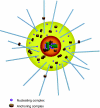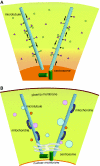The mammalian centrosome and its functional significance
- PMID: 18437411
- PMCID: PMC2386528
- DOI: 10.1007/s00418-008-0427-6
The mammalian centrosome and its functional significance
Abstract
Primarily known for its role as major microtubule organizing center, the centrosome is increasingly being recognized for its functional significance in key cell cycle regulating events. We are now at the beginning of understanding the centrosome's functional complexities and its major impact on directing complex interactions and signal transduction cascades important for cell cycle regulation. The centrosome orchestrates entry into mitosis, anaphase onset, cytokinesis, G1/S transition, and monitors DNA damage. Recently, the centrosome has also been recognized as major docking station where regulatory complexes accumulate including kinases and phosphatases as well as numerous other cell cycle regulators that utilize the centrosome as platform to coordinate multiple cell cycle-specific functions. Vesicles that are translocated along microtubules to and away from centrosomes may also carry enzymes or substrates that use centrosomes as main docking station. The centrosome's role in various diseases has been recognized and a wealth of data has been accumulated linking dysfunctional centrosomes to cancer, Alstrom syndrome, various neurological disorders, and others. Centrosome abnormalities and dysfunctions have been associated with several types of infertility. The present review highlights the centrosome's significant roles in cell cycle events in somatic and reproductive cells and discusses centrosome abnormalities and implications in disease.
Figures







References
-
- {'text': '', 'ref_index': 1, 'ids': [{'type': 'PMC', 'value': 'PMC2133110', 'is_inner': False, 'url': 'https://pmc.ncbi.nlm.nih.gov/articles/PMC2133110/'}, {'type': 'PubMed', 'value': '10209026', 'is_inner': True, 'url': 'https://pubmed.ncbi.nlm.nih.gov/10209026/'}]}
- Ahmad FJ, Yu W, McNally FJ, Baas PW (1999) An essential role for katanin in severing microtubules in the neuron. J Cell Biol 145:305–315 - PMC - PubMed
-
- {'text': '', 'ref_index': 1, 'ids': [{'type': 'PubMed', 'value': '14654843', 'is_inner': True, 'url': 'https://pubmed.ncbi.nlm.nih.gov/14654843/'}]}
- Andersen JS, Wilkinson CJ, Mayor T, Mortensen P, Nigg EA, Mann M (2003) Proteomic characterization of the human centrosome by protein correlation profiling. Nature 426:570–574 - PubMed
-
- {'text': '', 'ref_index': 1, 'ids': [{'type': 'PubMed', 'value': '9704896', 'is_inner': True, 'url': 'https://pubmed.ncbi.nlm.nih.gov/9704896/'}]}
- Baas PW (1998) The role of motor proteins in establishing the microtubule arrays of axons and dendrites. J Chem Neuroanat 14:175–180 - PubMed
-
- {'text': '', 'ref_index': 1, 'ids': [{'type': 'PubMed', 'value': '10027286', 'is_inner': True, 'url': 'https://pubmed.ncbi.nlm.nih.gov/10027286/'}]}
- Baas PW (1999) Microtubules and neuronal polarity: lessons from mitosis. Neuron 22:23–31 - PubMed
-
- {'text': '', 'ref_index': 1, 'ids': [{'type': 'PubMed', 'value': '15738963', 'is_inner': True, 'url': 'https://pubmed.ncbi.nlm.nih.gov/15738963/'}]}
- Badano JL, Teslovich TM, Katsanis N (2005) The centrosome in human genetic disease. Nat Rev Genet 6:194–205 - PubMed
Publication types
MeSH terms
Substances
LinkOut - more resources
Full Text Sources
Other Literature Sources

